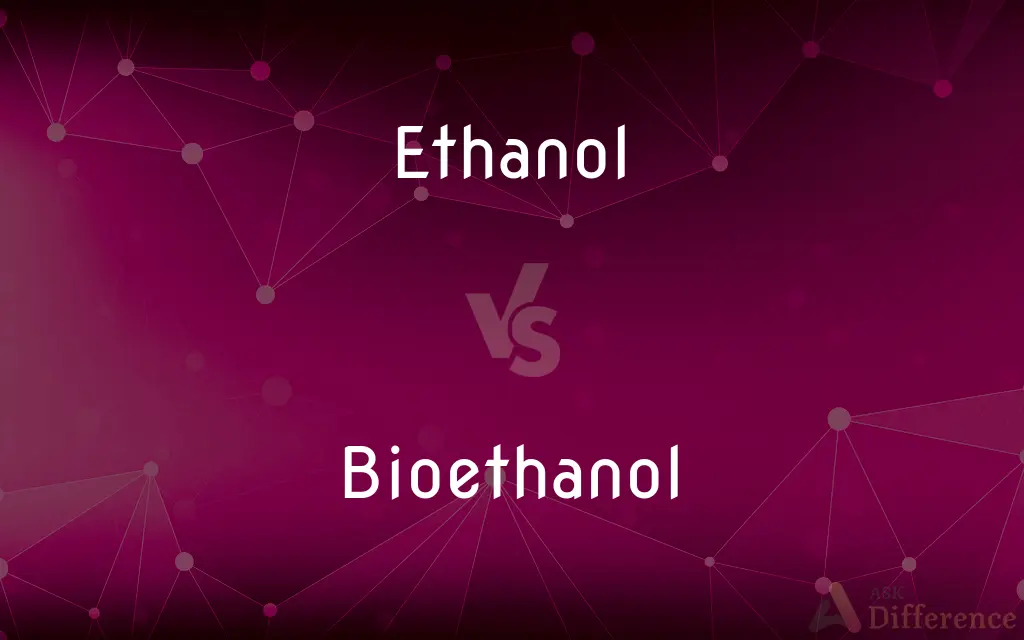Ethanol vs. Bioethanol — What's the Difference?
Edited by Tayyaba Rehman — By Urooj Arif — Updated on March 27, 2024
Ethanol is a common alcohol used as a fuel, solvent, and in manufacturing, whereas bioethanol is ethanol produced from biomass and is renewable and more environmentally friendly.

Difference Between Ethanol and Bioethanol
Table of Contents
ADVERTISEMENT
Key Differences
Ethanol is a versatile compound utilized in various applications, from being a primary ingredient in alcoholic beverages to serving as a solvent in the pharmaceutical industry. On the other hand, bioethanol specifically refers to ethanol produced through the fermentation of biomass, such as corn and sugarcane, highlighting its renewable nature and contribution to sustainable energy sources.
While ethanol serves as a key component in fuel blends to increase octane levels and improve emissions, bioethanol is particularly emphasized for its role in reducing greenhouse gas emissions when compared to fossil fuels. This environmental benefit is due to bioethanol's production from plants that absorb CO2, a greenhouse gas, during their growth cycle.
In the industrial sector, ethanol is produced both synthetically and through fermentation, using a variety of feedstocks including fossil fuels. Bioethanol, however, is produced exclusively through the biological process of fermenting sugars found in agricultural crops, emphasizing its biobased origin and sustainability.
The global market dynamics for ethanol are influenced by its diverse applications across industries, including fuel, pharmaceuticals, and personal care products. Bioethanol's market, in contrast, is primarily driven by the demand for renewable fuels and government policies aimed at reducing carbon footprints, reflecting its niche within the broader ethanol market.
Ethanol's production and use are well-established worldwide, with significant infrastructure and technology developed over decades. Bioethanol, while benefiting from advancements in fermentation technology, also focuses on innovations in feedstock utilization and efficiency improvements to enhance its competitiveness and environmental credentials.
ADVERTISEMENT
Comparison Chart
Source
Synthetic processes or biomass
Exclusively biomass
Production Process
Fermentation and synthetic methods
Fermentation of sugars from agricultural crops
Main Use
Fuel additive, solvent, beverages
Renewable fuel
Environmental Impact
Depends on source and production method
Lower carbon footprint, renewable
Market Drivers
Diverse applications across industries
Renewable energy policies, environmental concerns
Compare with Definitions
Ethanol
An intermediate in chemical synthesis.
Ethanol is a precursor to ethyl acetate and other chemicals.
Bioethanol
Produced through fermenting plant sugars.
Yeast ferments the sugars in biomass to produce bioethanol.
Ethanol
A colorless, volatile liquid used as a solvent.
Ethanol dissolves many organic compounds.
Bioethanol
An eco-friendly alternative to gasoline.
Bioethanol blends in fuel reduce carbon emissions from cars.
Ethanol
A biofuel component to reduce emissions.
Vehicles use ethanol-blended petrol for cleaner combustion.
Bioethanol
A step towards sustainable transportation.
Bioethanol is key in transitioning to renewable energy sources in transport.
Ethanol
A recreational substance in beverages.
Ethanol provides the alcoholic content in beer and wine.
Bioethanol
Supports agricultural economies.
Bioethanol production utilizes crops, benefiting farmers and rural areas.
Ethanol
Ethanol (also called ethyl alcohol, grain alcohol, drinking alcohol, or simply alcohol) is an organic chemical compound. It is a simple alcohol with the chemical formula C2H6O. Its formula can be also written as CH3−CH2−OH or C2H5OH (an ethyl group linked to a hydroxyl group), and is often abbreviated as EtOH. Ethanol is a volatile, flammable, colorless liquid with a slight characteristic odor.
Bioethanol
A renewable energy source from biomass.
Bioethanol is produced from sugarcane and corn.
Ethanol
See alcohol.
Bioethanol
Ethanol produced by fermenting the sugars in biomass materials such as corn, sugar beets, switchgrass, or agricultural residues, used as a fuel in internal-combustion engines either in pure form or more often as a gasoline additive.
Ethanol
(organic compound) A simple aliphatic alcohol formally derived from ethane by replacing one hydrogen atom with a hydroxyl group: CH3-CH2-OH.
Bioethanol
Ethanol produced, by fermentation of crops, for use as a biofuel.
Ethanol
Specifically, this alcohol as a fuel.
Ethanol
The organic compound C2H5.OH, the common alcohol which is the intoxicating agent in beer, wine, and other fermented and distilled liquors; called also ethyl alcohol. It is used pure or denatured as a solvent or in medicines and colognes and cleaning solutions, or mixed in gasoline as a fuel for automobiles, and as a rocket fuel (as in the V-2 rocket).
Ethanol
The intoxicating agent in fermented and distilled liquors; used pure or denatured as a solvent or in medicines and colognes and cleaning solutions and rocket fuel; proposed as a renewable clean-burning additive to gasoline
Common Curiosities
Is ethanol harmful to engines?
Ethanol can cause corrosion in older engines not designed for ethanol blends.
How is ethanol produced?
Ethanol is produced through fermentation of sugars or synthetic processes.
Can ethanol be made from petroleum?
Yes, ethanol can be synthesized from ethylene, which is derived from petroleum.
Is ethanol renewable?
Ethanol can be renewable if produced from biomass but is not exclusively so.
What makes bioethanol renewable?
Bioethanol is made from biomass, which can be replanted and regrown.
How does bioethanol help the environment?
It reduces greenhouse gas emissions by using carbon-absorbing plants as its source.
What are the main sources of bioethanol?
Corn, sugarcane, and other sugar or starch-rich crops.
What is ethanol used for?
Ethanol is used as a fuel additive, solvent, in beverages, and as an antiseptic.
Can bioethanol be used in all vehicles?
Not all vehicles are compatible with high bioethanol blends; modifications may be required.
How does bioethanol production benefit farmers?
It provides a market for surplus crops, potentially increasing income for farmers.
Share Your Discovery

Previous Comparison
Linux vs. Mac
Next Comparison
Switch vs. CommutatorAuthor Spotlight
Written by
Urooj ArifUrooj is a skilled content writer at Ask Difference, known for her exceptional ability to simplify complex topics into engaging and informative content. With a passion for research and a flair for clear, concise writing, she consistently delivers articles that resonate with our diverse audience.
Edited by
Tayyaba RehmanTayyaba Rehman is a distinguished writer, currently serving as a primary contributor to askdifference.com. As a researcher in semantics and etymology, Tayyaba's passion for the complexity of languages and their distinctions has found a perfect home on the platform. Tayyaba delves into the intricacies of language, distinguishing between commonly confused words and phrases, thereby providing clarity for readers worldwide.
















































